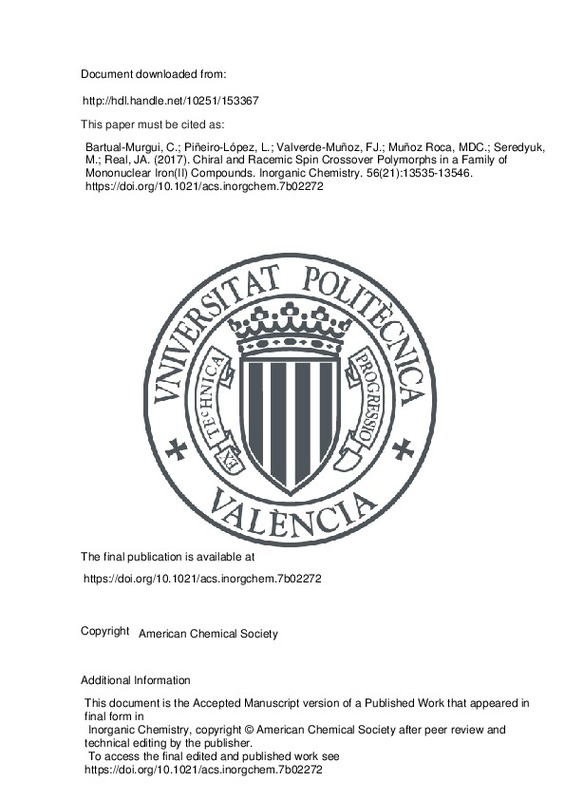JavaScript is disabled for your browser. Some features of this site may not work without it.
Buscar en RiuNet
Listar
Mi cuenta
Estadísticas
Ayuda RiuNet
Admin. UPV
Chiral and Racemic Spin Crossover Polymorphs in a Family of Mononuclear Iron(II) Compounds
Mostrar el registro sencillo del ítem
Ficheros en el ítem
| dc.contributor.author | Bartual-Murgui, Carlos
|
es_ES |
| dc.contributor.author | Piñeiro-López, Lucía
|
es_ES |
| dc.contributor.author | Valverde-Muñoz, Francisco Javier
|
es_ES |
| dc.contributor.author | Muñoz Roca, María Del Carmen
|
es_ES |
| dc.contributor.author | Seredyuk, Maksym
|
es_ES |
| dc.contributor.author | Real, José Antonio
|
es_ES |
| dc.date.accessioned | 2020-10-28T04:32:58Z | |
| dc.date.available | 2020-10-28T04:32:58Z | |
| dc.date.issued | 2017-11-06 | es_ES |
| dc.identifier.issn | 0020-1669 | es_ES |
| dc.identifier.uri | http://hdl.handle.net/10251/153367 | |
| dc.description | This document is the Accepted Manuscript version of a Published Work that appeared in final form in Inorganic Chemistry, copyright © American Chemical Society after peer review and technical editing by the publisher. To access the final edited and published work see https://doi.org/10.1021/acs.inorgchem.7b02272 | es_ES |
| dc.description.abstract | [EN] Understanding the origin of cooperativity and the equilibrium temperature of transition (T1/2) displayed by the spin-crossover (SCO) compounds as well as controlling these parameters are of paramount importance for future applications. For this task, the occurrence of polymorphism, presented by a number of SCO complexes, may provide deep insight into the influence of the supramolecular organization on the SCO behavior. In this context, herein we present a novel family of mononuclear octahedral FeII complexes with formula cis- [Fe(bqen)(NCX)2], where bqen is the chelating tetradentate ligand N,N¿-bis(8-quinolyl)ethane-1,2-diamine and X = S, Se. Depending on the preparation method, these compounds crystallize in either the orthorhombic or the trigonal symmetry systems. While the orthorhombic phase is composed of a racemic mixture of mononuclear complexes (polymorph I), the trigonal phase contains only one of the two possible enantiomers (¿ or ¿), thereby generating a chiral crystal (polymorph II). The four derivatives undergo SCO behavior with well-differentiated T1/2 values occurring in the interval 90¿233 K. On one hand, T1/2 is about 110 K (polymorph I) and 87 K (polymorph II) higher for the selenocyanate derivatives in comparison to those for their thiocyanate counterparts. These differences in T1/2 are ascribed not only to the higher ligand field induced by the selenocyanate anion but also to a remarkable difference in the structural reorganization of the [FeN6] coordination core upon SCO. Likewise, the higher cooperativity observed for the thiocyanate derivatives seems to be related to their stronger intermolecular interactions within the crystal. On the other hand, T1/2 is about 53 K (thiocyanate) and 29 K (selenocyanate) higher for the trigonal polymorph II in comparison to those for the orthorhombic polymorph I. These differences, and the small changes observed in cooperativity, stem from the slightly different hetero- and homochiral crystal packing generated by the cis-[Fe(bqen)(NCX)2] molecules, which determines subtle adaptations in the intermolecular contacts and the FeII coordination core. | es_ES |
| dc.description.sponsorship | We thank the Spanish Ministerio de Economia y Competitividad (MINECO) and FEDER funds (CTQ2013-46275-P and CTQ2016-78341-P and Unidad de Excelencia Maria de Maeztu MDM-2015-0538), Generalitat Valenciana (PROM-ETEO/2016/147), and EU Framework Program for Research and Innovation (RISE project number 734322). FJ.V.-M. thanks MINECO for a predoctoral FPI grant | es_ES |
| dc.language | Inglés | es_ES |
| dc.publisher | American Chemical Society | es_ES |
| dc.relation.ispartof | Inorganic Chemistry | es_ES |
| dc.rights | Reserva de todos los derechos | es_ES |
| dc.subject.classification | FISICA APLICADA | es_ES |
| dc.title | Chiral and Racemic Spin Crossover Polymorphs in a Family of Mononuclear Iron(II) Compounds | es_ES |
| dc.type | Artículo | es_ES |
| dc.identifier.doi | 10.1021/acs.inorgchem.7b02272 | es_ES |
| dc.relation.projectID | info:eu-repo/grantAgreement/EC/H2020/734322/EU/Multifunctional Spin Crossover Materials/ | es_ES |
| dc.relation.projectID | info:eu-repo/grantAgreement/MINECO//CTQ2013-46275-P/ES/SENSORES Y MEMORIAS BASADOS EN MATERIALES BIESTABLES CON TRANSICION DE ESPIN/ | es_ES |
| dc.relation.projectID | info:eu-repo/grantAgreement/GVA//PROMETEO2016%2F147/ | es_ES |
| dc.relation.projectID | info:eu-repo/grantAgreement/MINECO//CTQ2016-78341-P/ES/MATERIALES SPIN CROSSOVER BIESTABLES: DE LAS PROPIEDADES MACROSCOPICAS A LA ESPINTRONICA MOLECULAR/ | es_ES |
| dc.relation.projectID | info:eu-repo/grantAgreement/MINECO//MDM-2015-0538/ES/INSTITUTO DE CIENCIA MOLECULAR/ | es_ES |
| dc.rights.accessRights | Abierto | es_ES |
| dc.contributor.affiliation | Universitat Politècnica de València. Departamento de Física Aplicada - Departament de Física Aplicada | es_ES |
| dc.description.bibliographicCitation | Bartual-Murgui, C.; Piñeiro-López, L.; Valverde-Muñoz, FJ.; Muñoz Roca, MDC.; Seredyuk, M.; Real, JA. (2017). Chiral and Racemic Spin Crossover Polymorphs in a Family of Mononuclear Iron(II) Compounds. Inorganic Chemistry. 56(21):13535-13546. https://doi.org/10.1021/acs.inorgchem.7b02272 | es_ES |
| dc.description.accrualMethod | S | es_ES |
| dc.relation.publisherversion | https://doi.org/10.1021/acs.inorgchem.7b02272 | es_ES |
| dc.description.upvformatpinicio | 13535 | es_ES |
| dc.description.upvformatpfin | 13546 | es_ES |
| dc.type.version | info:eu-repo/semantics/publishedVersion | es_ES |
| dc.description.volume | 56 | es_ES |
| dc.description.issue | 21 | es_ES |
| dc.identifier.pmid | 29048915 | es_ES |
| dc.relation.pasarela | S\351182 | es_ES |
| dc.contributor.funder | Generalitat Valenciana | es_ES |
| dc.contributor.funder | Ministerio de Economía y Competitividad | es_ES |







![[Cerrado]](/themes/UPV/images/candado.png)

